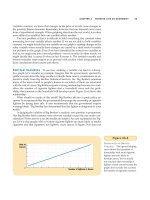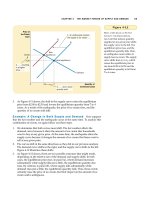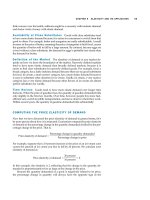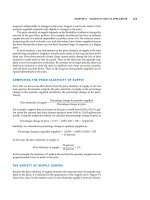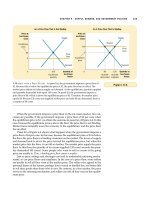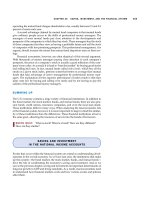Tài liệu Ten Principles of Economics - Part 55 docx
Bạn đang xem bản rút gọn của tài liệu. Xem và tải ngay bản đầy đủ của tài liệu tại đây (271.5 KB, 10 trang )
CHAPTER 25 SAVING, INVESTMENT, AND THE FINANCIAL SYSTEM 559
operating the mutual fund charges shareholders a fee, usually between 0.5 and 2.0
percent of assets each year.
A second advantage claimed by mutual fund companies is that mutual funds
give ordinary people access to the skills of professional money managers. The
managers of most mutual funds pay close attention to the developments and
prospects of the companies in which they buy stock. These managers buy the stock
of those companies that they view as having a profitable future and sell the stock
of companies with less promising prospects. This professional management, it is
argued, should increase the return that mutual fund depositors earn on their sav-
ings.
Financial economists, however, are often skeptical of this second argument.
With thousands of money managers paying close attention to each company’s
prospects, the price of a company’s stock is usually a good reflection of the com-
pany’s true value. As a result, it is hard to “beat the market” by buying good stocks
and selling bad ones. In fact, mutual funds called index funds, which buy all the
stocks in a given stock index, perform somewhat better on average than mutual
funds that take advantage of active management by professional money man-
agers. The explanation for the superior performance of index funds is that they
keep costs low by buying and selling very rarely and by not having to pay the
salaries of the professional money managers.
SUMMING UP
The U.S. economy contains a large variety of financial institutions. In addition to
the bond market, the stock market, banks, and mutual funds, there are also pen-
sion funds, credit unions, insurance companies, and even the local loan shark.
These institutions differ in many ways. When analyzing the macroeconomic role
of the financial system, however, it is more important to keep in mind the similar-
ity of these institutions than the differences. These financial institutions all serve
the same goal—directing the resources of savers into the hands of borrowers.
QUICK QUIZ: What is stock? What is a bond? How are they different?
How are they similar?
SAVING AND INVESTMENT
IN THE NATIONAL INCOME ACCOUNTS
Events that occur within the financial system are central to understanding devel-
opments in the overall economy. As we have just seen, the institutions that make
up this system—the bond market, the stock market, banks, and mutual funds—
have the role of coordinating the economy’s saving and investment. And as we
saw in the previous chapter, saving and investment are important determinants of
long-run growth in GDP and living standards. As a result, macroeconomists need
to understand how financial markets work and how various events and policies
affect them.
560 PART NINE THE REAL ECONOMY IN THE LONG RUN
As a starting point for an analysis of financial markets, we discuss in this sec-
tion the key macroeconomic variables that measure activity in these markets. Our
emphasis here is not on behavior but on accounting. Accounting refers to how var-
ious numbers are defined and added up. A personal accountant might help an in-
dividual add up his income and expenses. A national income accountant does the
same thing for the economy as a whole. The national income accounts include, in
particular, GDP and the many related statistics.
The rules of national income accounting include several important identities.
Recall that an identity is an equation that must be true because of the way the vari-
ables in the equation are defined. Identities are useful to keep in mind, for they
clarify how different variables are related to one another. Here we consider some
accounting identities that shed light on the macroeconomic role of financial
markets.
SOME IMPORTANT IDENTITIES
Recall that gross domestic product (GDP) is both total income in an economy
and the total expenditure on the economy’s output of goods and services. GDP
T
HE
U.S.
STOCK MARKET EXPERIENCED A
quadrupling of stock prices during the
1990s. The following article tries to ex-
plain this remarkable boom. It suggests
that people bid up stock prices because
they came to view stocks as less risky
than they previously thought.
Are Stocks Overvalued?
Not a Chance
B
Y
J
AMES
K. G
LASSMAN
AND
K
EVIN
A. H
ASSETT
The Dow Jones Industrial Average has
returned more than 200 percent over
the past five years, and the past three
have set an all-time record. So it’s
hardly surprising that many observers
worry the stock market is overvalued.
One of the most popular measures of
valuation, the ratio of a stock’s price to
its earnings per share, P/E, is close to
an all-time high. The P/E of the average
stock on the Dow is 22.5, meaning that
it costs $22.50 to buy $1 in profits—or,
conversely, that an investor’s return
(earnings divided by price) is just 4.4
percent, vs. 5.9 percent for long-term
Treasury bonds.
Yet Warren Buffett, chairman of
Berkshire Hathaway Corp. and the
most successful large-scale investor of
our time, told shareholders in a March
14 letter that “there is no reason to
think of stocks as generally overval-
ued” as long as interest rates remain
low and businesses continue to oper-
ate as profitably as they have in recent
years. Investors were buoyed by this
statement, even though Mr. Buffett
provided no analysis to back up his as-
sertion.
Mr. Buffett is right—and we have
the numbers and the theory to back him
up. Worries about overvaluation, we be-
lieve, are based on a serious and wide-
spread misunderstanding of the returns
and risks associated with equities. We
are not so foolish as to predict the short-
term course of stocks, but we are not re-
luctant to state that, based on modest
assumptions about interest rates and
profit levels, current P/E levels give us
no great concern—nor would levels as
much as twice as high.
The fact is that if you hold stocks in-
stead of bonds the amount of money
flowing into your pockets will be higher
over time. Why? Both bonds and stocks
provide their owners with a flow of cash
over time. For bonds, the arithmetic is
simple: If you buy a $10,000 bond paying
6 percent interest today, you’ll receive
$600 every year. For equities, the math
is more complicated: Assume that a
stock currently yields 2 percent, or $2
for each share priced at $100. Say you
own 100 shares; total dividend payments
are $200—much lower than for bonds.
IN THE NEWS
The Stock Market Boom
of the 1990s
CHAPTER 25 SAVING, INVESTMENT, AND THE FINANCIAL SYSTEM 561
(denoted as Y) is divided into four components of expenditure: consumption (C ),
investment (I), government purchases (G), and net exports (NX). We write
Y ϭ C ϩ I ϩ G ϩ NX.
This equation is an identity because every dollar of expenditure that shows up on
the left-hand side also shows up in one of the four components on the right-hand
side. Because of the way each of the variables is defined and measured, this equa-
tion must always hold.
In this chapter, we simplify our analysis by assuming that the economy we are
examining is closed. A closed economy is one that does not interact with other
economies. In particular, a closed economy does not engage in international trade
in goods and services, nor does it engage in international borrowing and lending.
Of course, actual economies are open economies—that is, they interact with other
economies around the world. (We will examine the macroeconomics of open
economies later in this book.) Nonetheless, assuming a closed economy is a useful
simplification by which we can learn some lessons that apply to all economies.
Moreover, this assumption applies perfectly to the world economy (inasmuch as
interplanetary trade is not yet common).
But wait. There is a big difference.
Profits grow over time. If that dividend
should increase with profits, say at a
rate of 5 percent annually, then, by the
30th year, your annual dividend payment
will be over $800, or one-third more than
the bond is yielding. The price of the
stock almost certainly will have risen
as well.
By this simple exercise, we can see
that stocks—even with their profits
growing at a moderate 5 percent—will
return far more than bonds over long pe-
riods. Over the past 70 years, stocks
have annually returned 4.8 percent-
age points more than long-term U.S.
Treasury bonds and 6.8 points more
than Treasury bills, according to Ibbot-
son Associates Inc., a Chicago research
firm.
But isn’t that extra reward—what
economists call the “equity premium”—
merely the bonus paid by the market to
investors who accept higher risk, since
returns for stocks are so much more un-
certain than for bonds? To this question,
we respond: What extra risk?
In his book “Stocks for the Long
Run,” Jeremy J. Siegel of the University
of Pennsylvania concludes: “It is widely
known that stock returns, on average,
exceed bonds in the long run. But it is lit-
tle known that in the long run, the risks in
stocks are less than those found in
bonds or even bills!” Mr. Siegel looked
at every 20-year holding period from
1802 to 1992 and found that the worst
real return for stocks was an annual av-
erage of 1.2 percent and the best was
an annual average of 12.6 percent. For
long-term bonds, the range was
minus
3.1 percent to plus 8.8 percent; for T-
bills, minus 3.0 percent to plus 8.3 per-
cent.
Based on these findings, it would
seem that there should be no need for
an equity risk premium at all—and that
the correct valuation for the stock mar-
ket would be one that equalizes the
present value of cash flow between
stocks and bonds in the long run. Think
of the market as offering you two assets,
one that will pay you $1,000 over the
next 30 years in a steady stream and
another that, just as surely, will pay you
the $1,000, but the cash flow will vary
from year to year. Assuming you’re in-
vesting for the long term, you will value
them about the same. . . .
Allow us now to suggest a hypothe-
sis about the huge returns posted by the
stock market over the past few years:
As mutual funds have advertised the re-
duction of risk acquired by taking the
long view, the risk premium required by
shareholders has gradually drifted down.
Since Siegel’s results suggest that the
correct risk premium might be zero, this
drift downward—and the corresponding
trend toward higher stock prices—may
not be over. . . . In the current environ-
ment, we are very comfortable both in
holding stocks and in saying that pundits
who claim the market is overvalued are
foolish.
Source: The Wall Street Journal, Monday, March 30,
1998, p. A18.
562 PART NINE THE REAL ECONOMY IN THE LONG RUN
Because a closed economy does not engage in international trade, imports and
exports are exactly zero. Therefore, net exports (NX) are also zero. In this case, we
can write
Y ϭ C ϩ I ϩ G.
This equation states that GDP is the sum of consumption, investment, and gov-
ernment purchases. Each unit of output sold in a closed economy is consumed, in-
vested, or bought by the government.
To see what this identity can tell us about financial markets, subtract C and G
from both sides of this equation. We obtain
Y Ϫ C Ϫ G ϭ I.
The left-hand side of this equation (Y Ϫ C Ϫ G) is the total income in the economy
that remains after paying for consumption and government purchases: This
amount is called national saving, or just saving, and is denoted S. Substituting
S for Y Ϫ C Ϫ G, we can write the last equation as
S ϭ I.
This equation states that saving equals investment.
To understand the meaning of national saving, it is helpful to manipulate the
definition a bit more. Let T denote the amount that the government collects from
households in taxes minus the amount it pays back to households in the form of
transfer payments (such as Social Security and welfare). We can then write na-
tional saving in either of two ways:
S ϭ Y Ϫ C Ϫ G
or
S ϭ (Y Ϫ T Ϫ C) ϩ (T Ϫ G).
These equations are the same, because the two T ’s in the second equation cancel
each other, but each reveals a different way of thinking about national saving. In
particular, the second equation separates national saving into two pieces: private
saving (Y Ϫ T Ϫ C) and public saving (T Ϫ G).
Consider each of these two pieces. Private saving is the amount of income that
households have left after paying their taxes and paying for their consumption. In
particular, because households receive income of Y, pay taxes of T, and spend C on
consumption, private saving is Y Ϫ T Ϫ C. Public saving is the amount of tax reve-
nue that the government has left after paying for its spending. The government re-
ceives T in tax revenue and spends G on goods and services. If T exceeds G, the
government runs a budget surplus because it receives more money than it spends.
This surplus of T Ϫ G represents public saving. If the government spends more
than it receives in tax revenue, then G is larger than T. In this case, the government
runs a budget deficit, and public saving T Ϫ G is a negative number.
Now consider how these accounting identities are related to financial markets.
The equation S ϭ I reveals an important fact: For the economy as a whole, saving must
national saving (saving)
the total income in the
economy that remains after
paying for consumption and
government purchases
private saving
the income that households
have left after paying for taxes
and consumption
public saving
the tax revenue that the government
has left after paying for its spending
budget surplus
an excess of tax revenue over
government spending
budget deficit
a shortfall of tax revenue from
government spending
CHAPTER 25 SAVING, INVESTMENT, AND THE FINANCIAL SYSTEM 563
be equal to investment. Yet this fact raises some important questions: What mecha-
nisms lie behind this identity? What coordinates those people who are deciding
how much to save and those people who are deciding how much to invest? The
answer is: the financial system. The bond market, the stock market, banks, mutual
funds, and other financial markets and intermediaries stand between the two sides
of the S ϭ I equation. They take in the nation’s saving and direct it to the nation’s
investment.
THE MEANING OF SAVING AND INVESTMENT
The terms saving and investment can sometimes be confusing. Most people use
these terms casually and sometimes interchangeably. By contrast, the macroecon-
omists who put together the national income accounts use these terms carefully
and distinctly.
Consider an example. Suppose that Larry earns more than he spends and de-
posits his unspent income in a bank or uses it to buy a bond or some stock from a
corporation. Because Larry’s income exceeds his consumption, he adds to the na-
tion’s saving. Larry might think of himself as “investing” his money, but a macro-
economist would call Larry’s act saving rather than investment.
In the language of macroeconomics, investment refers to the purchase of new
capital, such as equipment or buildings. When Moe borrows from the bank to
build himself a new house, he adds to the nation’s investment. Similarly, when the
U
SING SOME OF YOUR INCOME TO BUY STOCK
? M
OST PEOPLE CALL THIS INVESTING
.
M
ACROECONOMISTS CALL IT SAVING
.
